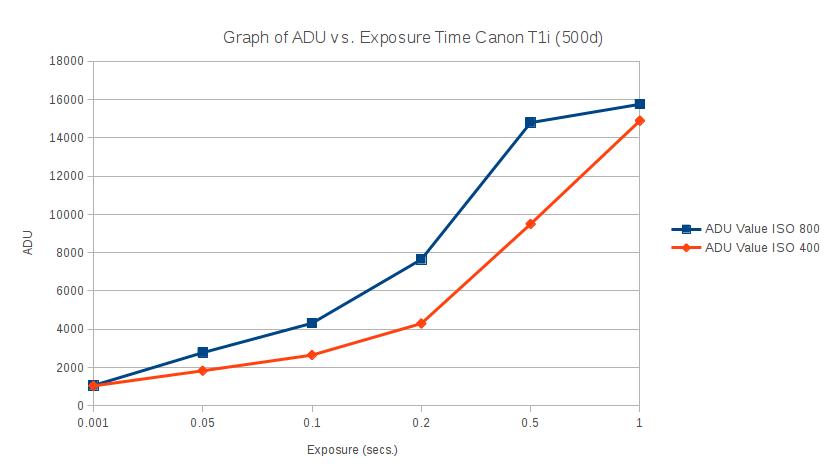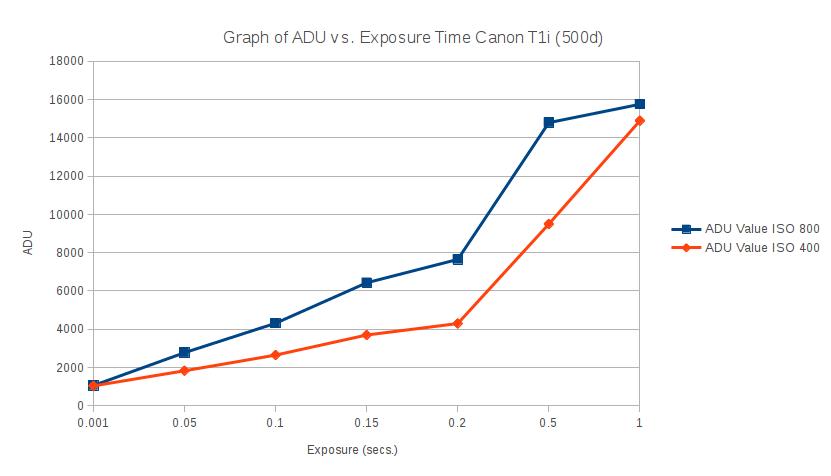×
INDI Library v2.0.7 is Released (01 Apr 2024)
Bi-monthly release with minor bug fixes and improvements
DSLR automated flats progress
DSLR automated flats progress was created by Jon
Has the issue with DSLR automated flats with regards to the linear relationship to CCD's been addressed? I have been experimenting taking some automated flats with my 550d at various initial exposures but it seems that it just takes an image at whatever I set as the initial exposure. If it has, does anyone know what the adu percentage should be? I've read that something like 8192 is a good start assuming linearity with a 20-25% exposure for 16 bit CCD cameras. Thanks.....
--Jon
--Jon
7 years 9 months ago
#9060
Please Log in or Create an account to join the conversation.
Replied by Jon on topic DSLR automated flats progress
I see now that the 8192 just matches up to 50% of the histogram for the 14 bit camera...which is pretty much what I have been doing with the camera using AV mode manually.
Another question...I know the Canon t1i has a 14 bit a/d converter. Does anyone know if this translates to mean that the camera has 14 bits per pixel?
--Jon
Another question...I know the Canon t1i has a 14 bit a/d converter. Does anyone know if this translates to mean that the camera has 14 bits per pixel?
--Jon
7 years 9 months ago
#9072
Please Log in or Create an account to join the conversation.
- Jasem Mutlaq
-

- Away
- Administrator
-

Replied by Jasem Mutlaq on topic DSLR automated flats progress
Not yet, I'm open to any suggestions. Feel free to submit a patch if you can figure out the algorithm for it.
7 years 9 months ago
#9073
Please Log in or Create an account to join the conversation.
- Jasem Mutlaq
-

- Away
- Administrator
-

Replied by Jasem Mutlaq on topic DSLR automated flats progress
Not yet, I'm open to any suggestions. Feel free to submit a patch if you can figure out the algorithm for it.
7 years 9 months ago
#9074
Please Log in or Create an account to join the conversation.
Replied by Jon on topic DSLR automated flats progress
To make sure i'm interpreting the code correctly, the issue that needs to be resolved is determining the value to be applied to activeJob->getExposure(). Currently, the initial exposure values are constant 1.5/.75 and the next exposure correction is adjusted up or down (depending on the resultant adu (value)) and the result of llsq? i.e. llsq is the current algorithm or are we needing to correct ADUSlope = (ExpRaw2 - ExpRaw1) / (ADURaw2 - ADURaw1)?
If it's the latter, would it be best to ignore the original values passed in from the user (values) for exposure and adu and use fixed exposures to determine the actual aduslope and then pass in the users adu value on the next pass and apply the aduslope to that to determine exposure values? In essence, in the end, you would be ignoring the users exposure value altogether.....
The linearity for this method should work pretty well, even for DSLR's, because we're talking short exposures taken late in the imaging process and the temps are stable here and the dark current really shouldn't wreak too much havoc with things.....
--Jon
If it's the latter, would it be best to ignore the original values passed in from the user (values) for exposure and adu and use fixed exposures to determine the actual aduslope and then pass in the users adu value on the next pass and apply the aduslope to that to determine exposure values? In essence, in the end, you would be ignoring the users exposure value altogether.....
The linearity for this method should work pretty well, even for DSLR's, because we're talking short exposures taken late in the imaging process and the temps are stable here and the dark current really shouldn't wreak too much havoc with things.....
--Jon
Please Log in or Create an account to join the conversation.
- Jasem Mutlaq
-

- Away
- Administrator
-

Replied by Jasem Mutlaq on topic DSLR automated flats progress
It's basically a simple linear least square fitting to predict the next exposure that would correspond to the desired ADU value and then rinse and repeat. Try taking exposure of an evenly illuminated field and then post the exposure + ADU values, is that linear or non-linear?
7 years 9 months ago
#9089
Please Log in or Create an account to join the conversation.
Replied by Jon on topic DSLR automated flats progress
The following user(s) said Thank You: Jasem Mutlaq
7 years 9 months ago
#9092
Please Log in or Create an account to join the conversation.
Replied by Jon on topic DSLR automated flats progress
7 years 9 months ago
#9097
Please Log in or Create an account to join the conversation.
Replied by Jon on topic DSLR automated flats progress
Based on these results, and some further reading) would it be appropriate to consider that, for DSLR's, you just look for the point where the linearity goes away?
--Jon
--Jon
7 years 9 months ago
#9099
Please Log in or Create an account to join the conversation.
- Jasem Mutlaq
-

- Away
- Administrator
-

Replied by Jasem Mutlaq on topic DSLR automated flats progress
Well, I'll do trials with my DSLR. How did you take the flats? Just point the camera against a white wall?
The following user(s) said Thank You: Jon
7 years 9 months ago
#9108
Please Log in or Create an account to join the conversation.
Replied by Jon on topic DSLR automated flats progress
I use an EL panel I built....
--Jon
--Jon
7 years 9 months ago
#9110
Please Log in or Create an account to join the conversation.
Time to create page: 0.455 seconds
© 2003-2022 by INDI Library. All rights reserved.


